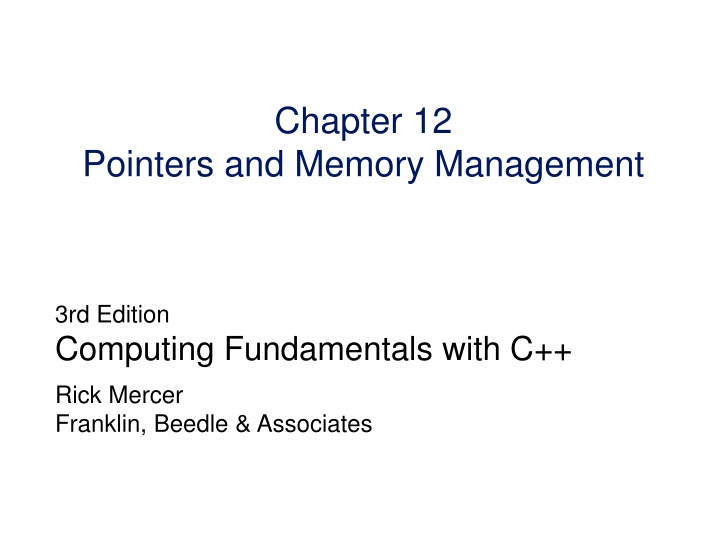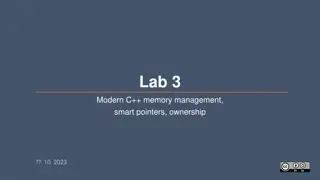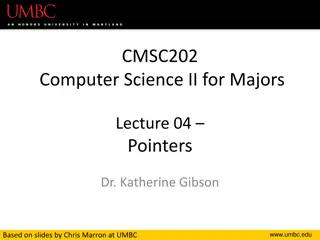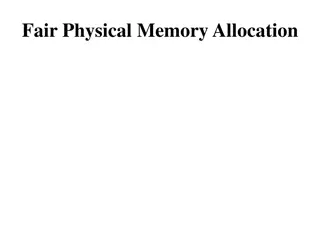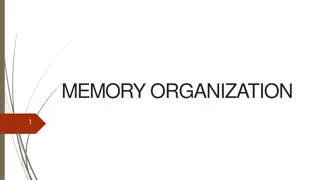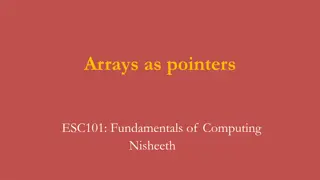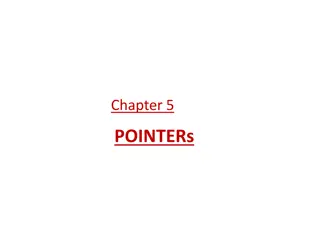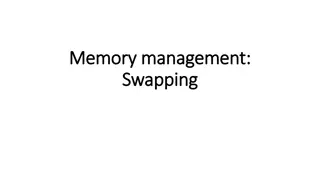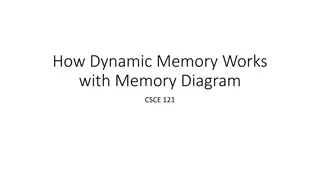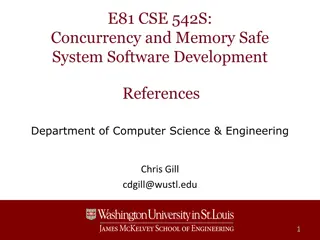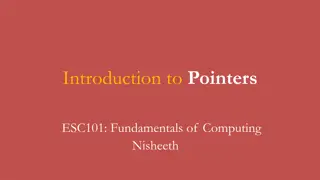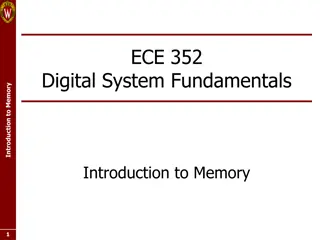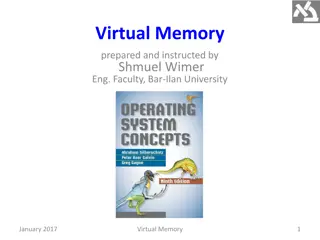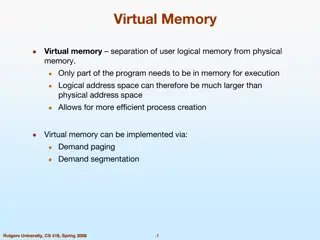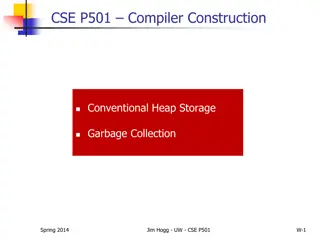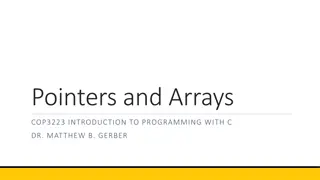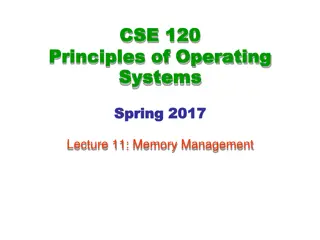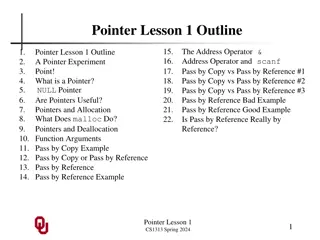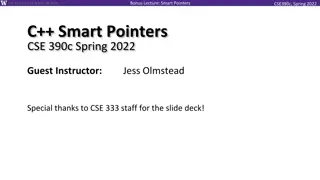Pointers and Memory Management in C++ Fundamentals
This content delves into pointers and memory management in C++, covering topics such as understanding how pointers store addresses of objects, using primitive arrays, initializing pointers, and utilizing new and delete operators for memory management. Explore the concepts of addresses, static and dynamic memory allocation, and different pointer types to enhance your understanding of memory handling in programming.
Download Presentation

Please find below an Image/Link to download the presentation.
The content on the website is provided AS IS for your information and personal use only. It may not be sold, licensed, or shared on other websites without obtaining consent from the author.If you encounter any issues during the download, it is possible that the publisher has removed the file from their server.
You are allowed to download the files provided on this website for personal or commercial use, subject to the condition that they are used lawfully. All files are the property of their respective owners.
The content on the website is provided AS IS for your information and personal use only. It may not be sold, licensed, or shared on other websites without obtaining consent from the author.
E N D
Presentation Transcript
Chapter 12 Pointers and Memory Management 3rd Edition Computing Fundamentals with C++ Rick Mercer Franklin, Beedle & Associates
Goals Understand pointers store addresses of other objects Use primitive C++ arrays with no range checking Use several methods for initializing pointers Use the new and delete operators for memory management
Memory Considerations In addition to name, state, and operations, every object has an address, where the values are stored Objects also have a lifetime beginning with construction to when they are no longer accessible With the following initialization, we see that the name charlie, state 99, and operations like = + cout << are known int charlie = 99; // But where is 99 stored?
Addresses An object's address is the actual memory location where the first byte of the object is stored The actual memory location is something we have not needed to know about until now We can't predict addresses, but ints are four bytes so two integers could have addresses 4 bytes apart int a = 123; int b = 456 Address Type 6300 int 6304 int Name a b State 123 456
Static and Dynamic Memory Allocation Some objects take a fixed amount of memory at compiletime: char int double Other objects require varying amounts of memory, which is allocated and deallocated dynamically, that is, at runtime, string for example We sometimes use pointers to allow for such dynamic objects
Pointers Pointer store addresses of other objects and are declared with * as follows: class-name*identifier; int anInt = 123; // The int object is initialized int* intPtr; // intPtr stores an address anInt stores an integer value intPtr stores the address of variable So pointer objects may store the address of other objects
About Pointer Types Pointer objects store the address of other objects which are the same type as the type of the pointer An int pointer hold an addresses to a int object int intP = 25; int* intPtr = &intP; A double pointer hold an addresses to a double double doubleD = 25.45; double* doublePtr = &doubleD; A Grid pointer hold an addresses to a Grid object Grid gridG(5, 5, 0, 0, south); Grid* gridPtr = &gridG;
The State of Pointers At this point, the value of intPtr may have or become one of these values Undefined (as intPtr exists above) The special value nullptr to indicate the pointer points to nothing: intPtr = nullptr; The address of the int object: intPtr=&anInt; & means address of
Pointer Values Currently, we may depict the undefined value of intPtr as follows: intPtr ??? The & symbol is called the address-of operator when it precedes an existing object This assignment returns the address of anInt and stores that address into intPtr: intPtr = &anInt;
Defining Pointer Objects The affect of this assignment intPtr = &anInt; is represented graphically like this: intPtr anInt 123 Now intPtr is defined
The State of Pointers We can change the value of anInt indirectly with the dereference operator * *intPtr = 97; // The same as anInt = 97 Now both objects are defined anInt or *intPtr intPtr 97
The dereference Operator intPtr anInt 97 The following code displays 97 and 96 cout << (*intPtr) << (*intPtr-1) << endl; This code changes 97 to 98 *intPtr = *intPtr + 1;
The & operator The & operator has different meanings depending on how you use it. When you use & to create a variable, you are creating a reference When you use & in front of an existing variable the & is called the address-of operator and returns the address of the variable and not the value stored in the variable
The * operator The * operator also has different meanings depending on how you use it. When you use * to create a variable, you are creating a pointer When you use * in front of an existing pointer, you get the value stored at the address the pointer contains and not the address stored in the pointer The * is also used in math operations when between numeric types
Address-of and Dereference What is the output generated by this program? #include <iostream> using namespace std; int main() { int *p1, *p2; int n1, n2; p1 = &n1; *p1 = 5; n2 = 10; p2 = &n2; cout << n1 << " " << *p1 << endl; cout << n2 << " " << *p2 << endl; return 0; }
Pointers to Objects Pointers can also store the addresses of objects with more than one value Because function calls have a higher precedence than dereferencing, override the priority scheme by wrapping the pointer dereference in parentheses BankAccount anAcct("Ashley", 123.45); BankAccount* bp; bp = &anAcct; (*bp).deposit(123.43); cout << (*bp).getBalance(); // 246.88
Arrow Operator -> C++ also has an arrow operator to send message to object via its address (location in memory) BankAccount anAcct("Ashley", 123.45); BankAccount* bp; bp = &anAcct; bp->deposit(123.43); cout << bp->getBalance(); // 246.88
The Primitive C Array C++ has primitive arrays string myFriends[20]; // store up to 20 strings double x[100]; // store up to 100 numbers There is no range checking with these
Compare C arrays to vector Difference vector Example C Array Example vector <int> x(100, 0); int x[100]; All garbage vectors can initialize all vector elements at construction; arrays cannot. vectors can be easily resized at runtime; arrays take a lot more work. All elements are 0 int n; cin >> n; x.resize(n); Can "grow" an array with more code vectors can be made to prevent out-of-range subscripts. You are told something is wrong cin >> x.at(100); Destroys other memory cin >> x[100]; No #include required #include <vector> vectors require an #include primitive, built-in arrays do not.
The Array/Pointer Connection A primitive array is actually a pointer The array name is actually the memory location of the very first array element Individual array elements are referenced like this address of 1st array element + ( subscript * size of 1 element) Arrays are automatically passed by reference when the parameter has [] void init(int x[], int & n) // Both x and n are reference parameters
Array parameters are reference parameters When passing arrays as parameters, you don't need & x and anArray reference the same array object
Allocating Memory with New Pointers can also be set with the C++ new operator This code allocates a contiguous block of memory to store the state. It also returns the address, or a pointer to the object int* intPtr = new int; *intPtr = 123; cout << *intPtr; // 123 This code allocates a new array int* nums = new int[10]; ? ? ? ? ? ? ? ? ? ? nums [0] [1] [2] [3] [4] [5] [6] [7] [8] [9]
The delete Operator new allocates memory at runtime delete deallocates that memory to avoid memory leaks so it can be used by other new objects General form for recycling memory delete pointer; delete[] pointer-to-array; For the programs you write, you won't notice any difference by forgetting to delete In a future course with destructors, or in an internship or job, you probably will
